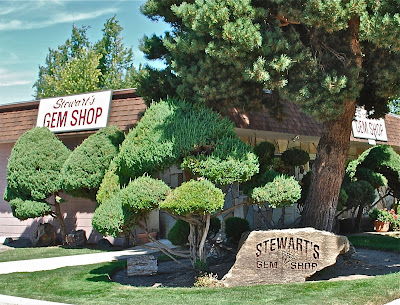 |
| After a couple of days, a dark, greenish-brown tint developed in the inner container. |
Chasing the Stars
Dedicated to sharing information about the state gemstone
of Idaho: Star Garnet.
Also providing updates on my book (in progress) about their history & gemology.
Wednesday, February 15, 2012
Using Oxalic Acid to Clean Idaho Star Garnet Rough
Tuesday, November 8, 2011
How to Clean Star Garnet Rough
The use of oxalic acid is a well known method for removing iron oxide staining from quartz and I've heard it recommended for star garnet crystals too. Commonly known as "wood bleach", most hardware stores carry it in stock. The downside to oxalic acid is that it is corrosive and toxic. I've been avoiding cleaning my crystals with this method since I share my workshop with a very inquisitive Siamese Cat. Just like a small child- I know he'll find a way into this potential toxic garnet stew.
Recently, I heard of a much easier suggestion- a brass bristle brush. Steel might work too. I had neither. However, I am restoring a rusted-out cabbing machine and do have a rust/paint stripping abrasive wheel (manufactured by 3M) that fits into a hand power drill. Here are the results:
This is a great method for a peek into your garnet rough- especially if you don't have a cabbing machine setup. I did test for asterism with the "oil test" and discoverd that this crystal will yield some brightly starred gems. Has anyone tried the brass or steel brush method?
Saturday, October 1, 2011
Stewart's Gem Shop of Boise, Idaho along with a writing update
Thursday, July 28, 2011
Mining for star garnets in Idaho



Wednesday, July 27, 2011
Introduction
Diamonds... Rubies... Sapphires... Emeralds... Stories of these gems abound in romance and adventure. However, behind these renowned precious gems there lie hundreds more varieties of unique stones. Many are exceedingly rarer than the aforementioned “Big Four” and all have their own stories wanting to be told.
These other gemstones attract the esoteric, the scientists, adventurers and connoisseurs amongst us. Oftentimes, the histories they hold and the people they attract hold narratives as fascinating as the more well-known stones.
Garnet is one such gem. In its' most common colors- flashes of red or purple emanate out of a dark background- just like a burning coal. It was known since ancient times to the Greeks and Romans and is still commonly used today as the birthstone for January.
One of the rarest and most unusual varieties is known as “Star Garnet”.
A crystal of garnet, from only a handful of world locales, if cut properly, may reveal a four or six rayed star. The state of Idaho is home to one of the few places in the world where these types of crystals occur. It is both the heartland for star garnets and also home to the only “mine” where anyone can visit and collect crystals themselves.
This blog is dedicated to the progress of my book about Star Garnets: “Chasing the Stars”. As I make further progress, meet interesting people and discover new facts about the star garnets- I plan on updating this blog. Please keep checking back to follow my progress on my book.
Comments, questions and stories are all very welcome!
-Martin






